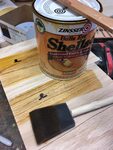We may receive a commission when you use our affiliate links. However, this does not impact our recommendations.
During the last decade, I’ve built a lot of six-board chests, including the examples found in this 2013 article in Popular Woodworking Magazine. For as long as I have been building these chests, I’ve been criticized for the way I fasten them with headed nails, which can result in the wood splintering a bit.
The crux of the question is this: Do you want to assemble an item so it is cosmetically perfect when it is complete, but that it might not last forever? Or do you want to use a tough fastener that will chew up the wood a bit but ensure your chest will last 500 years or more?
For me, the answer is simple. I am willing to endure some cosmetic flaws – even embrace them – when building things in order to ensure their long-term survival. In the case of six-board chests, this means using headed nails with a shank that is tapered (cut nails or Roman-style nails are ideal). The problem with these nails is that they tend to splinter the exterior of the chest a tad.
You can get around this splintering by using nails with a small head, but they won’t hold as well. (This is akin to using a bolt and nut without a washer.)
So I use headed nails. I angle them a bit to help hold the pieces together. And I’m not ashamed of any splintering.
This week, I was reminded of this fact while visiting the Hohensalzburg Castle in Salzburg Austria.Like many of the great castles in Europe, this one has a decent collection of old furniture, armor and artifacts from the last 1,000 years.
I spent some time examining the chests displayed in the living quarters, which are about 500 years old, according to castle officials. One of the chests is built like a classic six-board chest as shown in the article I wrote five years ago.
What’s more, all of the joints on this high-style piece show splintering at the corners from using headed nails.
If the idea of the splintering bothers you, think of it as an artifact of a visible joint, like seeing a wedge in a tenon. It’s clear evidence that the joint was assembled correctly. And it has 500 years of history to prove it.
— Christopher Schwarz
Here are some supplies and tools we find essential in our everyday work around the shop. We may receive a commission from sales referred by our links; however, we have carefully selected these products for their usefulness and quality.











